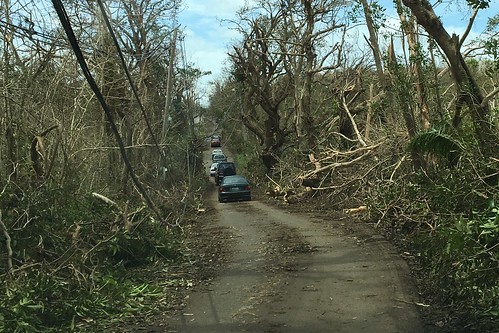
Last September when hurricanes Irma and Maria passed through the Caribbean they caused catastrophic damage to communities and infrastructure affecting homes, businesses, farms and forests across Puerto Rico and the U.S. Virgin Islands.
In the aftermath of this devastation the two great challenges facing the relief effort are to help bring back basic services and to learn from our experiences so that we are more resilient to future extreme climatic events.
Nearly 600 USDA employees live and work in Puerto Rico and the U.S. Virgin Islands, representing several USDA agencies. Like most residents, we prepared our homes and workplaces for Hurricane Irma, which hit the Virgin Islands and northeastern Puerto Rico September 8th. Many of us lost power for several days but we were soon back at work assessing damages and gearing up for recovery.
However, less than two weeks later, the winds from Hurricane Maria arrived and by the early morning of September 20th the full force of the storm hit St. Croix and Puerto Rico.
As the storm passed it left in its path near total defoliation of trees and downed power lines. Coupled with flooding, the loss of communication and electricity has had the most apparent effects. It’s difficult to predict when an extreme event will occur but we can predict and prepare for the consequences.
Now, two months after the storms, trees have begun to leaf out, many roads are clear and disaster assessments are underway, but conditions are still difficult. Power, water, communications and other infrastructure have yet to be fully restored, adding to challenges at work and home. The full extent of the storm’s effects on farms, forests and communities are yet to be determined.
Local USDA employees, agencies and leadership have been playing an important role in the recovery, by clearing roads and waterways, assisting with needs for power, assessing and assisting with livestock related health issues in the hard hit poultry and dairy sectors, implementing disaster relief programs, and helping communities that surround our facilities.
The complexity of the response within and among islands has highlighted the need to work across USDA’s agencies boundaries to deliver services to hard hit communities. The USDA Climate Hubs are designed to share climate related knowledge among USDA agencies and help each agency expand their capacity.
As the recovery continues the challenge is to learn about the effects of extreme events on our farms and forests, transportation, communications and energy systems, and on the supporting industries and markets to ensure the delivery of agricultural goods and ecological services. USDA has a great deal of capacity to learn by monitoring incentive and relief programs and through research programs.
We can expect more extremes in heat, drought, fire, flooding, and storms. By investing in learning and working across agencies to apply what we know, we can reduce the risks and costs of extreme climatic events, increase our resistance and resilience, and keep important services flowing from our land and water.
